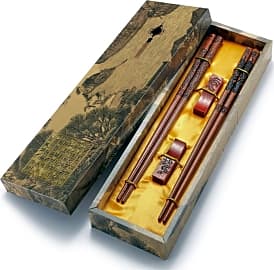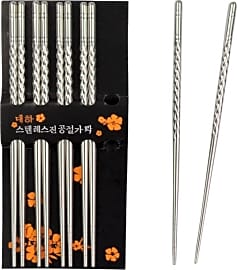The 10 Best Chopsticks

This wiki has been updated 33 times since it was first published in January of 2017. Whether you're cooking up your own stir fry or ordering takeout, if you're looking to add a little authenticity to your at-home Asian dining experience, check out our selection of chopsticks. We've included both reusable and disposable options in a variety of styles and materials, along with some that are ideal for beginners who are still learning this eating technique. When users buy our independently chosen editorial choices, we may earn commissions to help fund the Wiki.
Editor's Notes
August 05, 2020:
When updating this list we wanted to maintain a variety of materials by including fiberglass, steel, wood, melamine, titanium, and in the event of the ChopSabers Light Up, plastic. We also wanted to ensure a plethora of styles were present for myriad tastes, as well as numerous anti-slip features and shapes to appeal to every skill level.
When the Kurikatte Extra Strong and Keklle Gripsticks became unavailable, we took the opportunity to recommend the Rbenxia Classic, a Korean-inspired style at a budget-friendly price that should outlast any wooden option. These are lightweight and thin, ideal for picking up small pieces of food, and reusable many times over. The issue with stainless steel sets like this and the Liuna Luxury that people run into is a slipperiness despite notching and threading. This can make them tricky to use with wet foods, especially if you're a beginner. Many find that with practice, however, steel chopsticks can be mastered.
We also brought on the Zomchain Stylish for diners who want something elegant and tasteful, yet still up to the task of daily use. This set of two pairs comes with matching holders and a carrying case for portability, and are hand-polished, intricately engraved, and arrive with detailed instructions. These make a great gift but can also serve as a stylish addition to any table service.
Finally, if you're looking for a set of chopsticks for a little one or a beginner other than the House Of Stix Training Set, consider our list of training chopsticks.
March 13, 2019:
Removed the Kotobuki Wakasa Lacquer Shinonome and Bamber Anti-Slip 5-Pack due to availability concerns, along with The Chork 6 Pack as they are not the most durable option. Half bamboo and half stainless steel, the Hiware Reusable are perfect for the indecisive consumer, or for those with family members who can't agree on which type is best. The Kurikatte Extra Strong and FinessCity Titanium are both super-strong and come with their own carrying cases, making them ideal for travel, camping, and picnics. If you're looking for a set to use when you have guests or to give away as a gift, the Goldage Fiberglass and HuaLan Japanese are stylish and sophisticated, and they come in a variety of designs. Kids will love the novelty of the House Of Stix Training Set and ChopSabers Light Up, but the latter are a bit bulky and may be difficult for them to hold when first starting out.
Special Honors
Etsy Marketplace Those searching for singular chopstick sets should consider the offerings from the craftspeople at Etsy. There is an impressive array of designs to suit every taste, from iridescent steel and hand-carved wooden options to beautiful sets that come with matching bowls, boxes, various cutlery, charming holders, and pouches. etsy.com
ChopChop Sticks Personalized If you're looking for a unique gift for a close friend or family member or would like your own customized set for use at home, check out ChopChop Sticks. They specialize in custom-engraved, personalized chopsticks made from solid hardwood that is hand-selected for its quality. Crafted by experienced artisans, each piece is fine-polished and uses a combination of old-fashioned techniques and state-of-the-art laser engraving. You can also purchase boxes, silk and leather pouches, and more. chopchopsticks.com
Uncommon Goods Travel Set BPA and melamine-free, this German-made travel set from Uncommon Goods consists of thermoplastic chopsticks and spoons that snap together for on-the-go use. Perfect for ramen and pho, they're compact and easy to throw in a bag, recyclable, and dishwasher safe. uncommongoods.com
A Brief History Of Chopsticks
The first chopsticks were probably simple twigs or sticks, but since none survive, we have no way of knowing.
From what we can tell, chopsticks have been in use for around 9,000 years — or roughly as long as it took me to pick up this spicy tuna roll.
The utensils date back to China, likely sometime during the Xia Dynasty. The first chopsticks were probably simple twigs or sticks, but since none survive, we have no way of knowing.
Instead, the earliest known examples we actually have are made of bronze, and were used for cooking rather than eating.
It wasn't until 400 C.E. that people began to eat with them. This happened out of necessity, as resources were scarce and people needed to conserve fuel, so they chopped food into tiny pieces in order to cook it faster. This meant there was no need for knives at the dinner table, but people still needed a way to get the food from the plate to their mouths.
However, there was another reason why the Chinese were interested in ditching knives. The teachings of Confucius encouraged doing so, as he believed that having a weapon at the dinner table could encourage violence (he'd obviously been to Thanksgiving with my family). Confucian teachings are also responsible for why chopsticks have blunt ends, rather than sharp ones.
Beginning in about the 11th century, the utensils spread across most of the Asian world. In Japan, there were dedicated sets for men and women, with those made for men being about an inch longer. The Japanese also pioneered the use of disposable bamboo sets in 1878, although the wealthy would continue to use sticks made of jade, ivory, or other precious materials.
The disposable kind are the dominant form in America today, especially in restaurants. Many people have their own reusable models, though, which saves money while also reducing waste. You can find them in all manner of shapes and materials, allowing you to express your personality while you stuff your face.
For example, my personality is "the guy who can't use chopsticks."
How To Eat With Chopsticks
If you're out to dinner with friends or colleagues, seeing the chopsticks come out can be a nerve-wracking experience. It's hard enough to eat without getting it all over yourself when you're using utensils you're familiar with, and now they want to increase the level of difficulty?
Chopsticks aren't as intimidating as they seem, however. All it takes is a little know-how and practice.
Grab the sticks with your dominant hand while using the other one to make sure they're both even.
Grab the sticks with your dominant hand while using the other one to make sure they're both even. Then, tuck them into the web of your hand, holding them like you would a pencil. Let the other end rest lightly on your ring finger, and then wrap your thumb over them. They should be held firmly, but not with an iron grip (unless you're stabbing someone with them).
Hold the top stick with your thumb and index finger while keeping the lower one in place with your ring finger and the webbing of your thumb. The ends of both sticks should be even.
Practice moving the top stick up and down with your thumb and index finger. You can put the tip of your finger on top of the upper stick, allowing you to put downward pressure on whatever you're trying to grab while pinning it against the bottom stick.
Now you're ready to grab some food. It may take a little bit of effort, but you should be able to pick things up with a fair bit of control. Bring it slowly to your mouth, and don't squeeze the chopsticks together, as that's a great way to make the sticks go haywire and send sashimi flying across the restaurant.
Eating rice requires a little bit of a different technique. Instead of holding the sticks vertically, flip them so they're horizontal. Pinch a little bit of rice with the sticks, while keeping a bigger clump on top of the sticks. Scoop the whole thing up and carry it slowly to your gaping maw.
Again, don't squeeze the sticks, unless you're trying to make sure that the guy you hit with the sashimi has some rice to pair with it.
Proper Chopstick Etiquette
In many places, especially Japan, there are strict rules of etiquette regarding how to handle your chopsticks. If you don't want to accidentally offend someone, it would behoove you to learn the customs beforehand.
The biggest thing to keep in mind — and this is pretty universal across all cultures — is not to play with your chopsticks, or use them to draw attention. While you might think your walrus impression is hilarious, there's a good chance you'll be alone in that opinion.
The biggest thing to keep in mind — and this is pretty universal across all cultures — is not to play with your chopsticks, or use them to draw attention.
One of the biggest faux pas is sticking them standing upright in your rice. While this may seem like a smart place to rest them when not in use, it's seen as reminiscent of death — typically not something you want to remind people of at dinner.
Instead, when not using the sticks, place them on your plate, or on a rest if one's provided. Leaving them on the table is seen as rude, whereas stabbing them deep into your thigh is considered overly intimidating.
Don't eat directly off serving plates, either. Use your sticks (or the provided serving utensils) to grab however much you want to eat and transfer it to your plate. Also, don't spear the food, no matter how frustrated you get, and using a harpoon gun is highly frowned upon.
It's generally acceptable to bring your bowl closer to your face while eating, so don't be afraid to do this if you need to. It's vastly preferable to dropping rice into your lap.
The good news is that most rules are common sense, and you can generally watch your companions to gauge what is and isn't acceptable. One thing to keep in mind: if the chef comes to your table brandishing a butcher knife, you've probably done something wrong.















